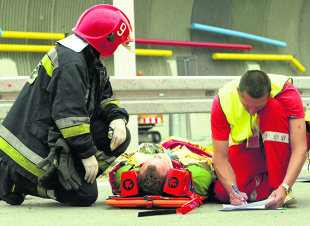
First aid, or what to do before the doctor arrives
 Every day we receive information about traffic accidents in which the health and life of people are in danger. Often, unfortunately, these messages are supplemented by an additional message: the perpetrator fled the scene of the accident without providing assistance to the victims. Such an attitude is not only reprehensible, but also punishable. Even if you cannot provide first aid, the life of an accident victim can be saved by calling for help as soon as possible.
Every day we receive information about traffic accidents in which the health and life of people are in danger. Often, unfortunately, these messages are supplemented by an additional message: the perpetrator fled the scene of the accident without providing assistance to the victims. Such an attitude is not only reprehensible, but also punishable. Even if you cannot provide first aid, the life of an accident victim can be saved by calling for help as soon as possible.
The end of the summer holidays and the resort fuss is ahead, and therefore the mass returns from their vacation spots. This is the time when  we must be especially careful on the way. But this is also the time when, unfortunately, knowledge of first aid can be useful in saving human life and health.
we must be especially careful on the way. But this is also the time when, unfortunately, knowledge of first aid can be useful in saving human life and health.
So, the first important step in an accident is to call the appropriate services (police, ambulance, fire department). It happens, however, that while waiting for the arrival of an ambulance, witnesses do not take any action - usually because they are unable to do so. And this may be the time on which the fate and even the life of the victim depends.
The first 3-5 minutes are decisive in providing first aid, this rather short time plays a decisive role in the struggle for the life of the victim. Quick first aid can save your life. However, most witnesses to the accident are afraid or, as we have said, do not know how to do it. And high-quality rescue measures allow preparing the victim for professional medical activities and thereby increasing his chances of survival.
As statistics confirms, most often we save our loved ones: our own children, spouses, parents, employees. In a word, companions. Therefore, it is worth not to be powerless at a time when the health and life of a loved one directly depends on us. With their hands and head at their disposal, anyone can save someone's life!
Early identification and calling of the appropriate emergency services is the first link in the life-saving chain of action. The ability to notify services of an incident is just as important as the implementation of life support measures. As soon as it becomes possible to promptly call an ambulance, start cardiopulmonary resuscitation as soon as possible (for two breaths - 30 clicks). The next step is early defibrillation (exposure to an electrical impulse on the heart muscle). Until a few years ago, only physicians around the world were authorized to perform defibrillation. Today, automated defibrillation equipment can be used by anyone who witnesses an accident requiring immediate assistance.
Waiting for an ambulance to arrive can take too long for the victim to survive. Immediate defibrillation gives a chance for salvation. If you place a defibrillator in the immediate vicinity of the accident site and use it correctly, the chance to save a human life reaches 70 percent. A person whose circulation has suddenly stopped can in most cases be saved only by an immediately applied electrical impulse. However, it is important that this happens no later than five minutes after the cardiac arrest. Therefore, defibrillators should be installed in public places so that as many people as possible have quick and easy access to them, says Meshko Skochilas of Physio-Control, a company that manufactures defibrillators, among other things.
The last link in the process of saving a person's life is professional medical care. Let us remember that common sense and a sober assessment of the situation increase the chances of health and survival, and when deciding to save human life, we always act in the name of the highest value. comp. on the
